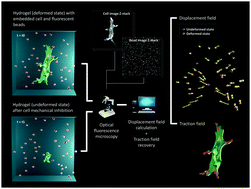Inverse method based on 3D nonlinear physically constrained minimisation in the framework of traction force microscopy†
Abstract
Traction force microscopy is a methodology that enables to estimate cellular forces from the measurement of the displacement field of an extracellular matrix (ECM)-mimicking hydrogel that a cell is mechanically interacting with. In this paper, a new inverse and physically-consistent methodology is developed and implemented in the context of 3D nonlinear elasticity. The proposed method searches for a displacement field that approximates the measured one, through the imposition of fulfillment of equilibrium with real and known forces acting in the hydrogel. The overall mathematical formulation leads to a constrained optimisation problem that is treated through a Lagrange operator and that is solved numerically by means of a nonlinear finite element framework. In order to illustrate the potential and enhanced accuracy of the proposed inverse method, it is applied to a total of 5 different real cases of cells cultured in a 3D hydrogel that is considered to behave as a nonlinear elastic material. Different error indicators are defined in order to compare ground truth simulated displacements and tractions to the ones recovered by the new inverse as well as by the forward method. Results indicate that the evaluation of displacement gradients leads to errors, in terms of recovered tractions, that are more than three times lower (on average) for the inverse method compared to the forward method. They highlight the enhanced accuracy of the developed methodology and the importance of appropriate inverse methods that impose physical constraints to traction and stress recovery in the context of traction force microscopy.

- This article is part of the themed collection: Force transmission by nonlinear biomaterials


 Please wait while we load your content...
Please wait while we load your content...